Multi-Temporal Change of LULC and Its Impact on Carbon Storage in Jiangsu Coastal, China
Abstract
:1. Introduction
2. Materials and Methods
2.1. Study Area
2.2. Datasets
2.3. Methods
2.3.1. The Analysis Methods of LULC Change
2.3.2. Carbon Storage Analysis Method
2.3.3. PLUS Model
3. Results
3.1. LULC Dynamics in Jiangsu Coast from 1980 to 2018
3.1.1. Multi-Temporal Changes of LULC during 1980–2018
3.1.2. The Contribution Transfer in/out Rate of Each LULC
3.2. Carbon Storage Dynamics in Jiangsu Coats from 1980 to 2018
3.2.1. The Spatiotemporal Change of Carbon Storage from 1980 to 2018
3.2.2. The Carbon Storage during 1980–2018
3.3. Quantitative Analysis of the Potential Driving of LULC and Carbon Storage Prediction
3.3.1. Analyzing the Drivers of LULC Changes Based on PLUS-LEAS
3.3.2. The Prediction of LULC and Carbon Storage in 2036
4. Discussion
5. Conclusions
Author Contributions
Funding
Data Availability Statement
Conflicts of Interest
References
- Crossland, C.J.; Baird, D.; Ducrotoy, J.-P.; Lindeboom, H.; Buddemeier, R.W.; Dennison, W.C.; Maxwell, B.A.; Smith, S.V.; Swaney, D.P. The Coastal Zone—A Domain of Global Interactions. In Coastal Fluxes in the Anthropocene: The Land-Ocean Interactions in the Coastal Zone Project of the International Geosphere-Biosphere Programme; Crossland, C.J., Kremer, H.H., Lindeboom, H.J., Marshall Crossland, J.I., Le Tissier, M.D.A., Eds.; Springer: Berlin/Heidelberg, Germany, 2005; pp. 1–37. [Google Scholar]
- Davis, R.A. Human Impact on Coasts. In Encyclopedia of Coastal Science; Finkl, C.W., Makowski, C., Eds.; Springer International Publishing: Cham, Switzerland, 2019; pp. 983–991. [Google Scholar]
- Xu, N.; Wang, Y.; Huang, C.; Jiang, S.; Jia, M.; Ma, Y. Monitoring coastal reclamation changes across Jiangsu Province during 1984–2019 using landsat data. Mar. Policy 2021, 136, 104887. [Google Scholar] [CrossRef]
- Besser, H.; Hamed, Y. Environmental impacts of land management on the sustainability of natural resources in Oriental Erg Tunisia, North Africa. Environ. Dev. Sustain. 2021, 23, 11677–11705. [Google Scholar] [CrossRef]
- Liu, Y.; Li, J. The patterns and driving mechanisms of reclaimed land use in China’s coastal areas in recent 30 years. Sci. Sin. Terrae 2020, 50, 761–774. (In Chinese) [Google Scholar]
- Tian, P.; Li, J.; Cao, L.; Pu, R.; Gong, H.; Liu, Y.; Zhang, H.; Chen, H. Impacts of reclamation derived land use changes on ecosystem services in a typical gulf of eastern China: A case study of Hangzhou bay. Ecol. Indic. 2021, 132, 108259. [Google Scholar] [CrossRef]
- Chuai, X.; Huang, X.; Wang, W.; Wu, C.; Zhao, R. Spatial Simulation of Land Use based on Terrestrial Ecosystem Carbon Storage in Coastal Jiangsu, China. Sci. Rep. 2014, 4, 5667. [Google Scholar] [CrossRef] [PubMed]
- Etemadi, H.; Smoak, J.M.; Karami, J. Land use change assessment in coastal mangrove forests of Iran utilizing satellite imagery and CA–Markov algorithms to monitor and predict future change. Environ. Earth Sci. 2018, 77, 208. [Google Scholar] [CrossRef]
- Pourebrahim, S.; Hadipour, M.; Bin Mokhtar, M. Impact assessment of rapid development on land use changes in coastal areas; case of Kuala Langat district, Malaysia. Environ. Dev. Sustain. 2014, 17, 1003–1016. [Google Scholar] [CrossRef]
- Rindfuss, R.; Walsh, S.; Turner, B.; Fox, J.; Mishra, V. Developing a science of land change: Challenges and methodological issues. Proc. Natl. Acad. Sci. USA 2004, 101, 13976–13981. [Google Scholar] [PubMed]
- Yang, R.; Chen, H.; Chen, S.; Ye, Y. Spatiotemporal evolution and prediction of land use/land cover changes and ecosystem service variation in the Yellow River Basin, China. Ecol. Indic. 2022, 145, 109579. [Google Scholar] [CrossRef]
- Stamp, L.D. The Land Utilisation Survey of Britain. Nature 1932, 129, 709–711. [Google Scholar] [CrossRef]
- Gaur, S.; Mittal, A.; Bandyopadhyay, A.; Holman, I.; Singh, R. Spatio-temporal analysis of land use and land cover change: A systematic model inter-comparison driven by integrated modelling techniques. Int. J. Remote Sens. 2020, 41, 9229–9255. [Google Scholar] [CrossRef]
- Pielke, R.A. Land Use and Climate Change. Science 2005, 310, 1625–1626. [Google Scholar] [CrossRef]
- Aitali, R.; Snoussi, M.; Kolker, A.S.; Oujidi, B.; Mhammdi, N. Effects of Land Use/Land Cover Changes on Carbon Storage in North African Coastal Wetlands. J. Mar. Sci. Eng. 2022, 10, 364. [Google Scholar] [CrossRef]
- Verburg, P.H.; Soepboer, W.; Veldkamp, A.; Limpiada, R.; Espaldon, V.; Mastura, S.S.A. Modeling the Spatial Dynamics of Regional Land Use: The CLUE-S Model. Environ. Manag. 2002, 30, 391–405. [Google Scholar] [CrossRef]
- Semadeni-Davies, A.; Jones-Todd, C.; Srinivasan, M.; Muirhead, R.; Elliott, A.; Shankar, U.; Tanner, C. CLUES model calibration and its implications for estimating contaminant attenuation. Agric. Water Manag. 2020, 228, 105853. [Google Scholar] [CrossRef]
- Ward, N.D.; Megonigal, J.P.; Bond-Lamberty, B.; Bailey, V.L.; Butman, D.; Canuel, E.A.; Diefenderfer, H.; Ganju, N.K.; Goñi, M.A.; Graham, E.B.; et al. Representing the function and sensitivity of coastal interfaces in Earth system models. Nat. Commun. 2020, 11, 2458. [Google Scholar] [CrossRef] [PubMed]
- Geng, B.; Zheng, X.; Fu, M. Scenario analysis of sustainable intensive land use based on SD model. Sustain. Cities Soc. 2017, 29, 193–202. [Google Scholar] [CrossRef]
- Guan, D.; Zhao, Z.; Tan, J. Dynamic simulation of land use change based on logistic-CA-Markov and WLC-CA-Markov models: A case study in three gorges reservoir area of Chongqing, China. Environ. Sci. Pollut. Res. 2019, 26, 20669–20688. [Google Scholar] [CrossRef]
- Şenik, B.; Kaya, H.S. Landscape sensitivity-based scenario analysis using flus model: A case of Asarsuyu watershed. Landsc. Ecol. Eng. 2022, 18, 139–156. [Google Scholar] [CrossRef]
- Liang, X.; Guan, Q.; Clarke, K.C.; Liu, S.; Wang, B.; Yao, Y. Understanding the drivers of sustainable land expansion using a patch-generating land use simulation (PLUS) model: A case study in Wuhan, China. Comput. Environ. Urban Syst. 2021, 85, 101569. [Google Scholar] [CrossRef]
- Li, C.; Wu, Y.; Gao, B.; Zheng, K.; Wu, Y.; Li, C. Multi-scenario simulation of ecosystem service value for optimization of land use in the Sichuan-Yunnan ecological barrier, China. Ecol. Indic. 2021, 132, 108328. [Google Scholar] [CrossRef]
- Zhang, X.; Zhou, Y.; Long, L.; Hu, P.; Huang, M.; Xie, W.; Chen, Y.; Chen, X. Simulation of land use trends and assessment of scale effects on ecosystem service values in the Huaihe River basin, China. Environ. Sci. Pollut. Res. 2023, 30, 58630–58653. [Google Scholar] [CrossRef]
- Fryer, J.; Williams, I.D. Regional carbon stock assessment and the potential effects of land cover change. Sci. Total. Environ. 2021, 775, 145815. [Google Scholar] [CrossRef]
- Woldesenbet, T.A.; Elagib, N.A.; Ribbe, L.; Heinrich, J. Catchment response to climate and land use changes in the Upper Blue Nile sub-basins, Ethiopia. Sci. Total. Environ. 2018, 644, 193–206. [Google Scholar] [CrossRef] [PubMed]
- Leal Filho, W.; Icaza, L.E.; Neht, A.; Klavins, M.; Morgan, E.A. Coping with the impacts of urban heat islands. A literature-based study on understanding urban heat vulnerability and the need for resilience in cities in a global climate change context. J. Clean. Prod. 2018, 171, 1140–1149. [Google Scholar] [CrossRef]
- Siikamäki, J.; Sanchirico, J.N.; Jardine, S.; McLaughlin, D.; Morris, D. Blue Carbon: Coastal Ecosystems, Their Carbon Storage, and Potential for Reducing Emissions. Environ. Sci. Policy Sustain. Dev. 2013, 55, 14–29. [Google Scholar] [CrossRef]
- Zhu, L.; Song, R.; Sun, S.; Li, Y.; Hu, K. Land use/land cover change and its impact on ecosystem carbon storage in coastal areas of China from 1980 to 2050. Ecol. Indic. 2022, 142, 109178. [Google Scholar] [CrossRef]
- El Mahrad, B.; Abalansa, S.; Newton, A.; Icely, J.D.; Snoussi, M.; Kacimi, I. Social-Environmental Analysis for the Management of Coastal Lagoons in North Africa. Front. Environ. Sci. 2020, 8, 37. [Google Scholar] [CrossRef]
- Khiavi, H.T.; Mostafazadeh, R. Land use change dynamics assessment in the Khiavchai region, the hillside of Sabalan mountainous area. Arab. J. Geosci. 2021, 14, 1–15. [Google Scholar] [CrossRef]
- Yang, W.; Jiang, X. Evaluating the influence of land use and land cover change on fine particulate matter. Sci. Rep. 2021, 11, 17612. [Google Scholar] [CrossRef] [PubMed]
- Chalazas, T.; Hasiotis, T.; Monioudi, I.; Andreadis, O.; Manoutsoglou, E.; Adonis, V. Evaluation of coastal vulnerability using the invest model—Case study: SE CHIOS Island. In Proceedings of the 3rd International Congress on Applied Ichthyology & Aquatic Environment, Volos, Greece, 8–11 November 2018. [Google Scholar]
- Gounaridis, D.; Chorianopoulos, I.; Symeonakis, E.; Koukoulas, S. A Random Forest-Cellular Automata modelling approach to explore future land use/cover change in Attica (Greece), under different socio-economic realities and scales. Sci. Total. Environ. 2018, 646, 320–335. [Google Scholar] [CrossRef]
- Hongli, S. Influence of Reclamation Activities on Ecosystem Type and Carbon Sink Function of the Coastal Wetland in the Yellow River Estuary. Ph.D. Thesis, Chinese Academy of Sciences (Northeast Institute of Geography and Agroecology), Beijing, China, 2015. [Google Scholar]
- Xiao, Y.; Zhang, L.; Zhang, L.Y.; Xiao, Y.; Zheng, H.; Ouyang, Z.Y. Spatial variation analysis of biodiversity in the Bohai region coastal wetland. Acta Ecol. Sin. 2018, 38, 909–916. [Google Scholar] [CrossRef]
- Peng, T.; Deng, H. Study on the division of main functional regions based on relative carrying capacity of resources: A case study of Guiyang, southwest China. Environ. Dev. Sustain. 2021, 23, 9493–9513. [Google Scholar] [CrossRef]
- Yeboah-Assiamah, E.; Muller, K.; Domfeh, K.A. ‘Complex crisis’ and the rise of collaborative natural resource governance: Institutional trajectory of a wildlife governance experience in Ghana. Environ. Dev. Sustain. 2017, 20, 2205–2224. [Google Scholar] [CrossRef]
- Spalding, A.K. Exploring the evolution of land tenure and land use change in Panama: Linking land policy with development outcomes. Land Use Policy 2017, 61, 543–552. [Google Scholar] [CrossRef]
- Shahfahad; Talukdar, S.; Rihan, M.; Hang, H.T.; Bhaskaran, S.; Rahman, A. Modelling urban heat island (UHI) and thermal field variation and their relationship with land use indices over Delhi and Mumbai metro cities. Environ. Dev. Sustain. 2022, 24, 3762–3790. [Google Scholar] [CrossRef]
- Hussain, S.; Lu, L.; Mubeen, M.; Nasim, W.; Karuppannan, S.; Fahad, S.; Tariq, A.; Mousa, B.G.; Mumtaz, F.; Aslam, M. Spatiotemporal Variation in Land Use Land Cover in the Response to Local Climate Change Using Multispectral Remote Sensing Data. Land 2022, 11, 595. [Google Scholar] [CrossRef]
- Hussain, S.; Qin, S.; Nasim, W.; Bukhari, M.A.; Mubeen, M.; Fahad, S.; Raza, A.; Abdo, H.G.; Tariq, A.; Mousa, B.G.; et al. Monitoring the Dynamic Changes in Vegetation Cover Using Spatio-Temporal Remote Sensing Data from 1984 to 2020. Atmosphere 2022, 13, 1609. [Google Scholar] [CrossRef]
- Wan, G.; Wang, X.; Zhang, R.; Zhang, X. The impact of road infrastructure on economic circulation: Market expansion and input cost saving. Econ. Model. 2022, 112, 105854. [Google Scholar] [CrossRef]
- Xiong, Y.; Liao, B.; Proffitt, E.; Guan, W.; Sun, Y.; Wang, F.; Liu, X. Soil carbon storage in mangroves is primarily controlled by soil properties: A study at Dongzhai Bay, China. Sci. Total. Environ. 2018, 619, 1226–1235. [Google Scholar] [CrossRef]
- Sun, T.; Ma, Z.; Huang, Z.; Wang, Z.; Chen, S.; Xiao, Y.; Xie, C.; Yue, C.; Jia, F.; Zhang, Q. Coastal Ecosystem Restoration Strategy Based on Carbon Storage Change: A Case Study of the Southeast Coastal Zone of Hainan Island. Trop. Geogr. 2023, 43, 443–458. [Google Scholar] [CrossRef]
- Wang, Y.-g.; Luo, G.-p.; Feng, Y.-x.; Han, Q.-f.; Fan, B.-b.; Chen, Y.-l. Effects of Land Use/Land Cover Change on Carbon Storage in Manas River Watershed over the Past 50 Years. J. Nat. Resour. 2013, 28, 994–1006. [Google Scholar] [CrossRef]
- Liu, Y.; Zhang, J.; Zhou, D.; Ma, J.; Dang, R.; Ma, J.; Zhu, X. Temporal and spatial variation of carbon storage in the Shule River Basin based on InVEST model. Acta Ecol. Sin. 2021, 41, 4052–4065. [Google Scholar]
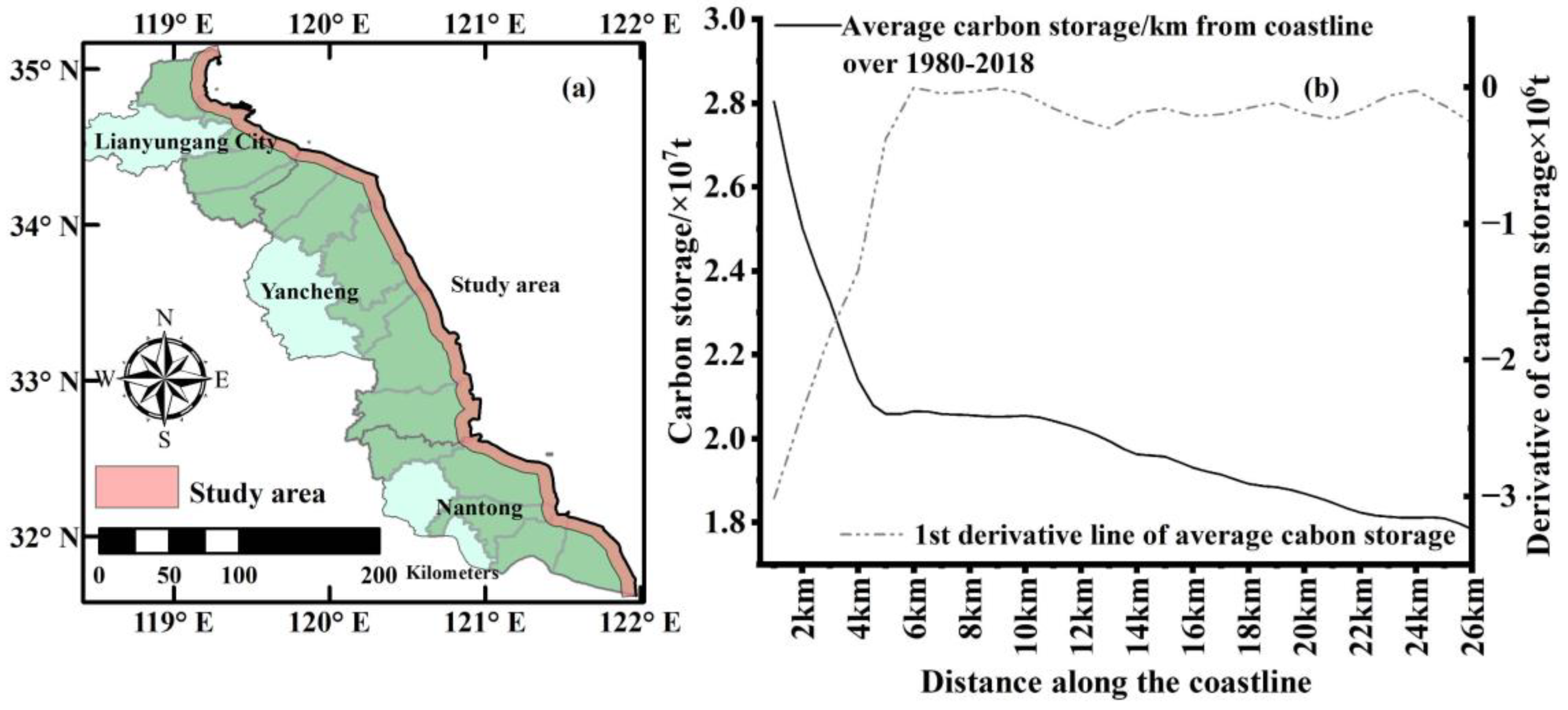
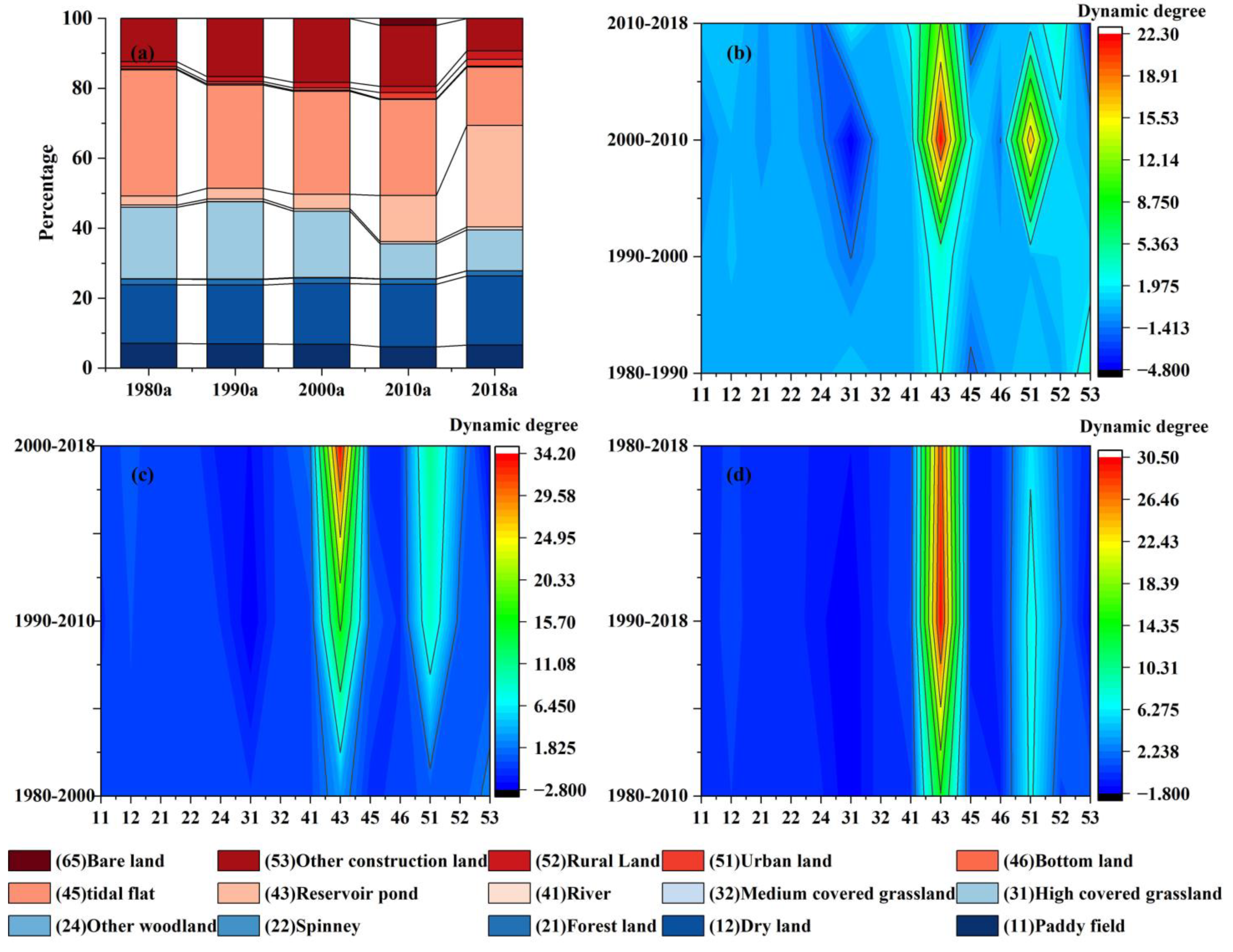

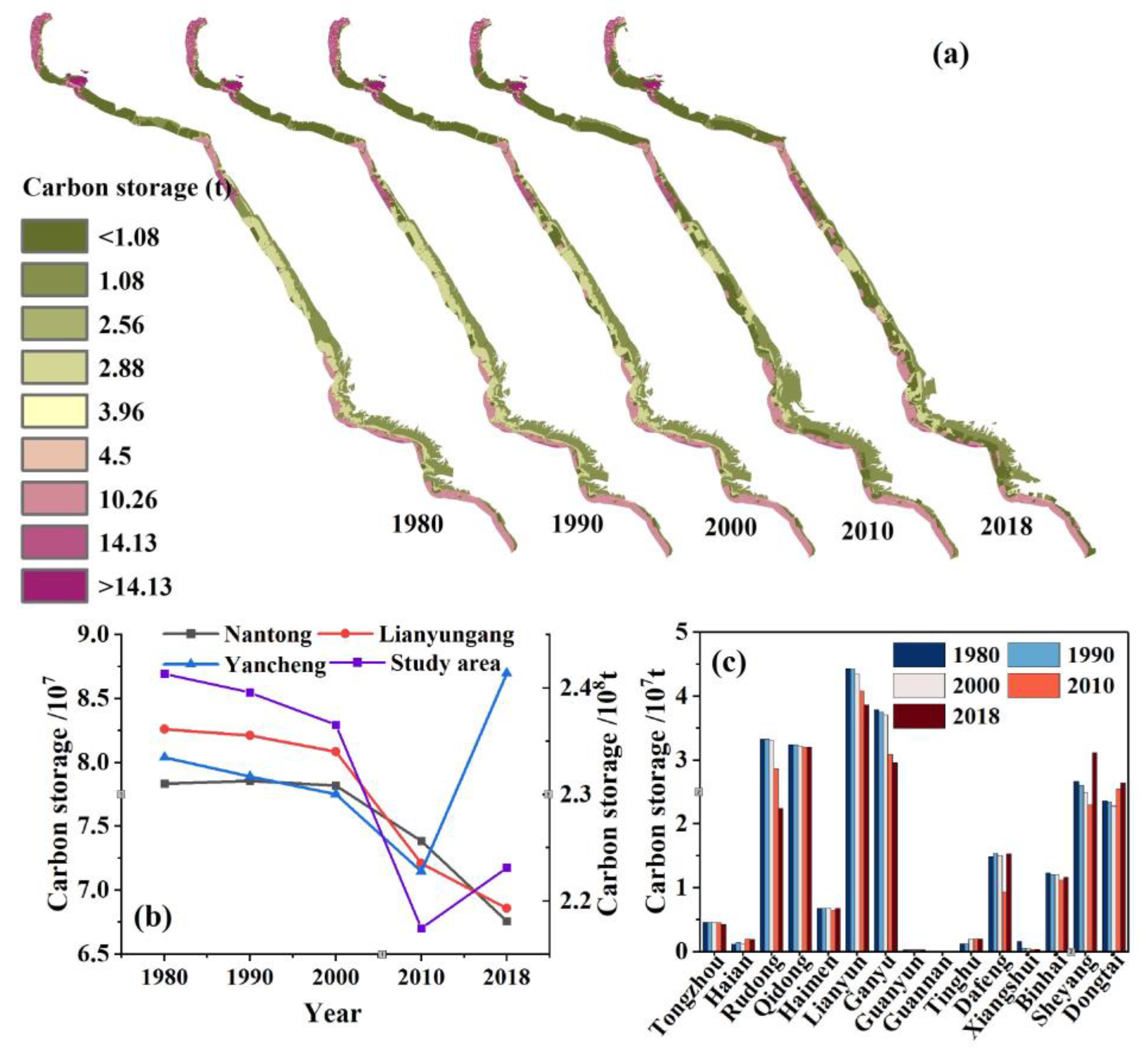
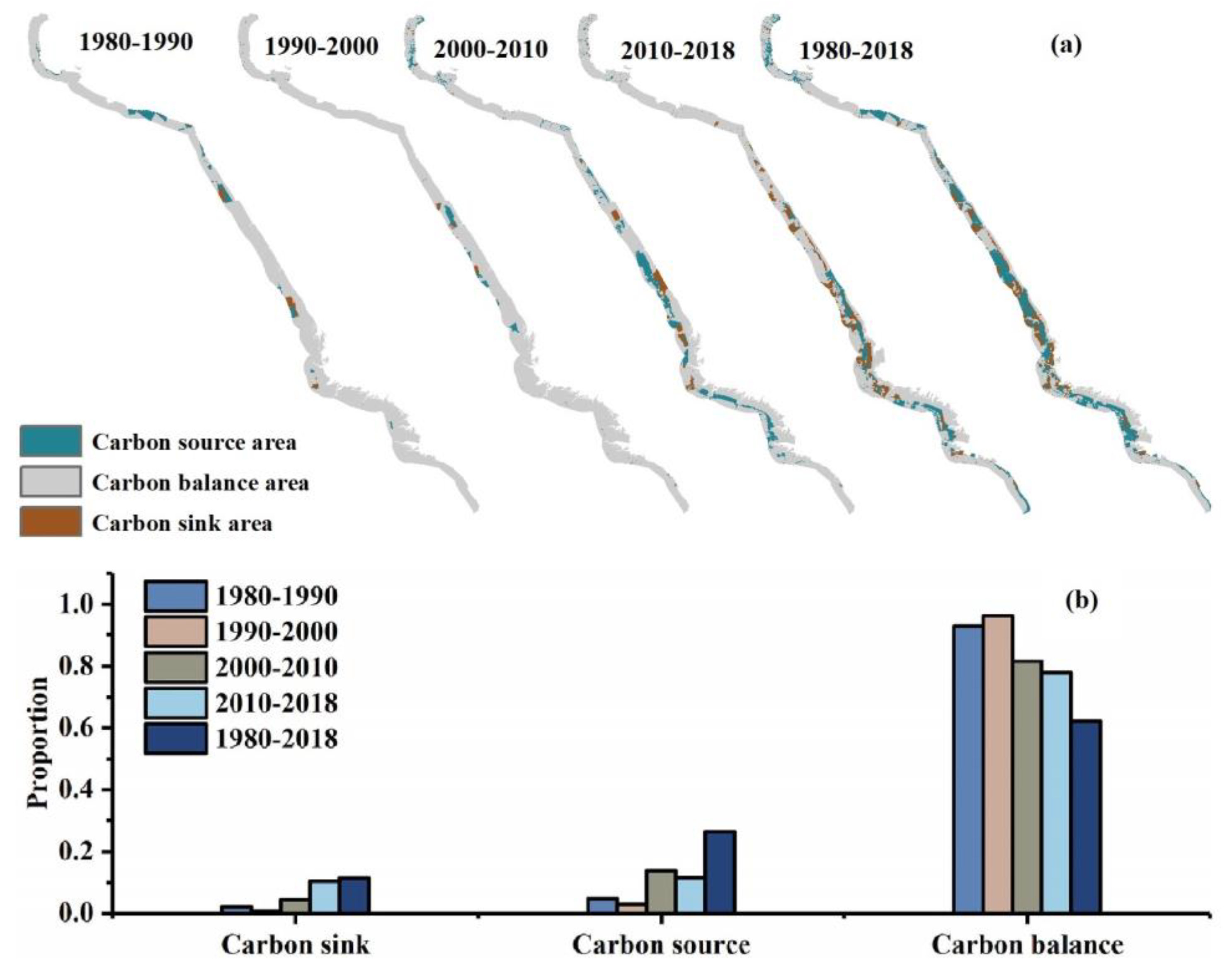
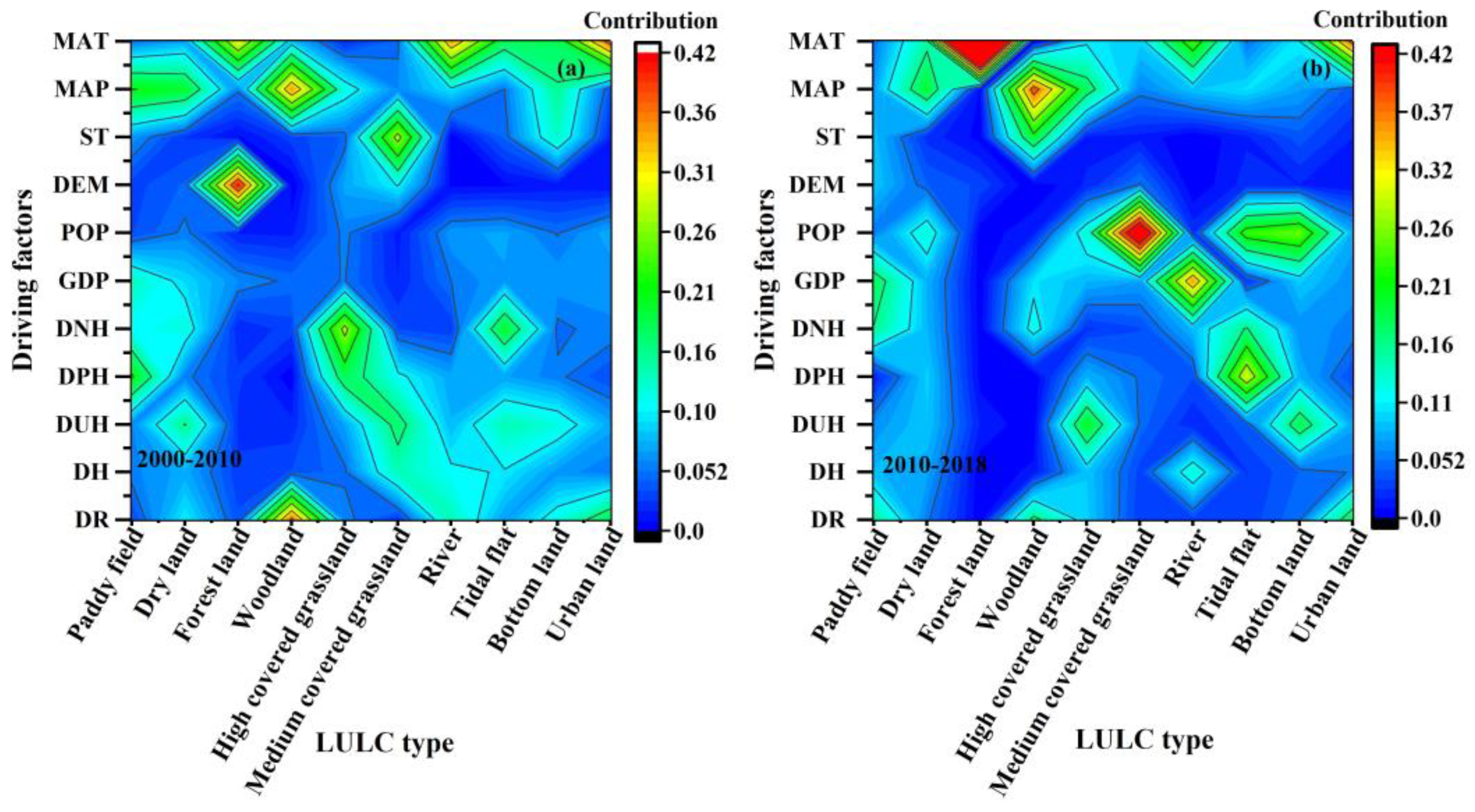

| Data | Data Attribute | Abbreviation | Year | Format and Resolution |
|---|---|---|---|---|
| Land use type | Land use/land cover | LULC | 1980, 1990, 2000, 2010, 2018. | Raster, 30 m |
| Environmental factor | The mean annual temperature | MAT | 2000, 2010, 2018. | Raster, 1 km |
| The mean annual precipitation | MAP | 2000, 2010, 2018. | Raster, 1 km | |
| Soil type | ST | 2010 | Raster, 1 km | |
| Digital elevation model | DEM | 2010 | Raster, 30 m | |
| Socio-economic factors | Gross domestic product | GDP | 2000, 2010, 2018. | Raster, 1 km |
| Population | POP | 2000, 2010, 2018. | Raster, 1 km | |
| Railway | DR | 2010 | Shapefile, - | |
| Highway | DH | 2010 | Shapefile, - | |
| National highway | DNH | 2010 | Shapefile, - | |
| Province highway | DPH | 2010 | Shapefile, - | |
| Urban first-grade highway | DUH | 2010 | Shapefile, - |
| LULC | /Mg·hm−2 | /Mg·hm−2 | /Mg·hm−2 | /Mg·hm−2 |
|---|---|---|---|---|
| Paddy field | 5 | 2 | 150 | 0 |
| Dry land | 3 | 1 | 110 | 0 |
| Forest land | 200 | 130 | 130 | 65 |
| Spinney | 8 | 8 | 25 | 3 |
| Other woodland | 10 | 3 | 90 | 1 |
| High covered grassland | 6 | 6 | 20 | 0 |
| Medium covered grassland | 4.2 | 4.2 | 20 | 0 |
| River | 0 | 0 | 0 | 0 |
| Reservoir pond | 0 | 0 | 0 | 0 |
| tidal flat | 1.5 | 0.5 | 10 | 0 |
| Bottom land | 1 | 1 | 10 | 0 |
| Urban land | 0 | 0 | 0 | 0 |
| Rural Land | 0 | 0 | 50 | 0 |
| Other construction land | 0 | 0 | 0 | 0 |
| Bare land | 10 | 5 | 20 | 0 |
Disclaimer/Publisher’s Note: The statements, opinions and data contained in all publications are solely those of the individual author(s) and contributor(s) and not of MDPI and/or the editor(s). MDPI and/or the editor(s) disclaim responsibility for any injury to people or property resulting from any ideas, methods, instructions or products referred to in the content. |
© 2023 by the authors. Licensee MDPI, Basel, Switzerland. This article is an open access article distributed under the terms and conditions of the Creative Commons Attribution (CC BY) license (https://creativecommons.org/licenses/by/4.0/).
Share and Cite
Yuan, H.; Zhang, J.; Wang, Z.; Qian, Z.; Wang, X.; Xu, W.; Zhang, H. Multi-Temporal Change of LULC and Its Impact on Carbon Storage in Jiangsu Coastal, China. Land 2023, 12, 1943. https://doi.org/10.3390/land12101943
Yuan H, Zhang J, Wang Z, Qian Z, Wang X, Xu W, Zhang H. Multi-Temporal Change of LULC and Its Impact on Carbon Storage in Jiangsu Coastal, China. Land. 2023; 12(10):1943. https://doi.org/10.3390/land12101943
Chicago/Turabian StyleYuan, Huanhuan, Jianliang Zhang, Zhi Wang, Zhedong Qian, Xiaoyue Wang, Wanggu Xu, and Haonan Zhang. 2023. "Multi-Temporal Change of LULC and Its Impact on Carbon Storage in Jiangsu Coastal, China" Land 12, no. 10: 1943. https://doi.org/10.3390/land12101943
APA StyleYuan, H., Zhang, J., Wang, Z., Qian, Z., Wang, X., Xu, W., & Zhang, H. (2023). Multi-Temporal Change of LULC and Its Impact on Carbon Storage in Jiangsu Coastal, China. Land, 12(10), 1943. https://doi.org/10.3390/land12101943







